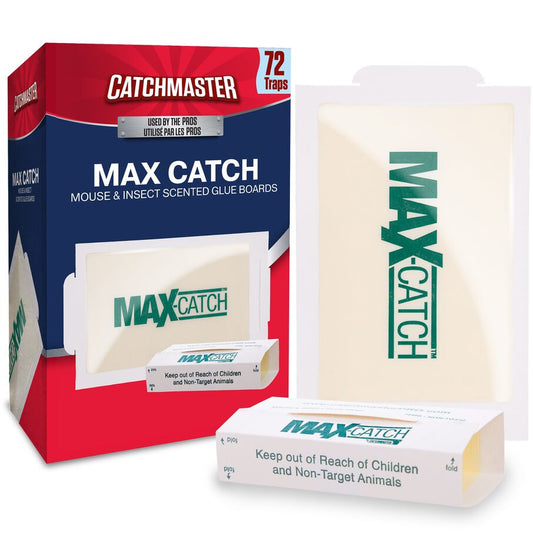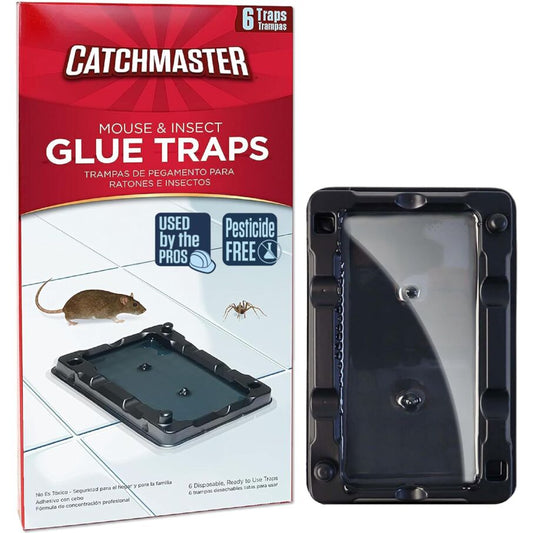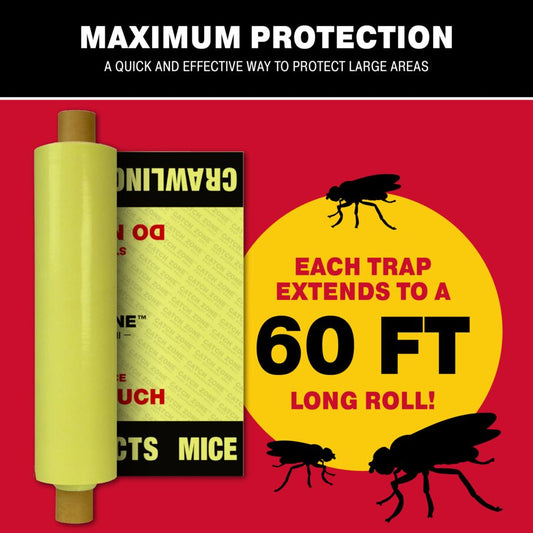Mouse Traps
We know how to catch mice! For over 70 years, Catchmaster® has been the go-to solution for professionals and homeowners alike. Our easy-to-use, cost-effective, and reliable mouse traps are designed to keep your home safe and pest-free.
-
Pro Strength Mouse & Insect Glue Boards
$16.99 – $25.99($1.42 - $0.43/trap)5.0 / 5.0
(74) 74 total reviews
Regular price From $16.99 USDRegular priceUnit price / per$16.99 USDSale price From $16.99 USD$16.99 USDFrom $14.45 USDQuick Add
Select Size

Pro Strength Mouse & Insect Glue Boards
-
Max-Catch Classic Glue Board Traps
$23.49 – $33.99($0.65 - $0.47/trap)4.9 / 5.0
(61) 61 total reviews
Regular price From $23.49 USDRegular priceUnit price / per$23.49 USDSale price From $23.49 USD$23.49 USDFrom $19.97 USDQuick Add
Select Size

Max-Catch Classic Glue Board Traps
-
Mouse and Insect Glue Board Traps
$28.49($0.38/trap)5.0 / 5.0
(32) 32 total reviews
Regular price $28.49 USDRegular priceUnit price / per$28.49 USDSale price $28.49 USD$28.49 USD$24.22 USD -
Max-Catch Unscented Glue Board Traps
$23.49 – $33.99($0.65 - $0.47/trap)4.9 / 5.0
(26) 26 total reviews
Regular price From $23.49 USDRegular priceUnit price / per$23.49 USDSale price From $23.49 USD$23.49 USDFrom $19.97 USDQuick Add
Select Size

Max-Catch Unscented Glue Board Traps
-
Rat, Mouse & Insect Glue Traps
$15.99 – $25.99($2.67 - $2.17/trap)4.9 / 5.0
(18) 18 total reviews
Regular price From $15.99 USDRegular priceUnit price / per$15.99 USDSale price From $15.99 USD$15.99 USDFrom $13.60 USDQuick Add
Select Size

Rat, Mouse & Insect Glue Traps
-
Pro Series Multi-Catch Mouse Trap Includes Replaceable Glue Board
$19.99 – $64.99($19.99 - $10.83/trap)4.9 / 5.0
(16) 16 total reviews
Regular price From $19.99 USDRegular priceUnit price / per$19.99 USDSale price From $19.99 USD$19.99 USDFrom $17.00 USDQuick Add
Select Size

Pro Series Multi-Catch Mouse Trap Includes Replaceable Glue Board
-
Mouse & Insect Glue Traps
$8.99 – $34.99($1.5 - $0.87/trap)5.0 / 5.0
(11) 11 total reviews
Regular price From $8.99 USDRegular priceUnit price / per$8.99 USDSale price From $8.99 USD$8.99 USDFrom $7.65 USDQuick Add
Select Size

Mouse & Insect Glue Traps
-
Gluee Louee Econo Extra Large Rat Traps
$49.99($1.67/trap)5.0 / 5.0
(3) 3 total reviews
Regular price $49.99 USDRegular priceUnit price / per$49.99 USDSale price $49.99 USD$49.99 USD$42.50 USD -
Catch Zone Pest Boundary Roll - Large Area Glue Trap
$84.99($84.99/trap)Regular price $84.99 USDRegular priceUnit price / per$84.99 USDSale price $84.99 USD$84.99 USD$72.25 USD -
Rodent & Insect Glue Trays for Cold Weather
$25.99($4.33/trap)5.0 / 5.0
(3) 3 total reviews
Regular price $25.99 USDRegular priceUnit price / per$25.99 USDSale price $25.99 USD$25.99 USD$22.10 USD -
Mouse & Insect Glue Trays for Cold Weather
$11.99($2.0/trap)Regular price $11.99 USDRegular priceUnit price / per$11.99 USDSale price $11.99 USD$11.99 USD$10.20 USD -
Pro Series Multi-Catch Glue Board Trap Refill
$16.99($1.42/trap)5.0 / 5.0
(1) 1 total reviews
Regular price $16.99 USDRegular priceUnit price / per$16.99 USDSale price $16.99 USD$16.99 USD$14.45 USD -
Pest Protection Kit with Glue Boards and Trays
$14.99($1.87/trap)Regular price $14.99 USDRegular priceUnit price / per$14.99 USDSale price $14.99 USD$14.99 USD$12.75 USD -
Pro Series Multi-Catch Mini Mouse Trap
$51.49($8.58/trap)Regular price $51.49 USDRegular priceUnit price / per$51.49 USDSale price $51.49 USD$51.49 USD$43.77 USD -
Mouse & Insect Super Glue Traps
$21.99($0.73/trap)5.0 / 5.0
(8) 8 total reviews
Regular price $21.99 USDRegular priceUnit price / per$21.99 USDSale price $21.99 USD$21.99 USD$18.70 USD -
Pro Series Multi-Catch Mini Mouse Trap Refills
$25.99($0.36/trap)Regular price $25.99 USDRegular priceUnit price / per$25.99 USDSale price $25.99 USD$25.99 USD$22.10 USD
Safe and Effective Mice Traps for Your Home
All of our sticky mouse traps are made of non-toxic, high-quality, effective, and specially formulated glue to handle any size mouse problem. We are proud to offer one of the few non-toxic, home and family-safe mouse control solutions on the market.
How Does a Mouse Trap Work?
Dusty, dirty, dry, damp, hot, and cold - Catchmaster has sticky mouse traps for any place and any condition around your home. Once a mouse steps onto our trap, it’s caught until you remove it.
Our mouse glue traps are the most unique on the market. Mice often bring secondary problems into your home, including ticks, fleas, dander, and bacteria & viruses. When the animal is caught in a mouse trap, those secondary problems will fall off the host. If you choose Catchmaster, they fall onto the adhesive surface of our sticky mouse traps and are trapped forever!
For a more durable solution, our mouse snap traps are powerful, reusable, and easy to set. Unlike traditional wooden traps, they feature a specially designed bait cup that ensures better positioning, maximizing your catch while protecting your space!
Why Choose Catchmaster Mice Traps?
Catchmaster is the trusted brand used by professionals in the industry. Our long history of quality products and commitment to customer service has made us the go-to solution for pest control. When you need reliable, effective mouse traps, trust the professionals—trust Catchmaster!
Shop Mouse Traps That Work
Put an end to your mouse problem. Whether you need a quick fix for a minor issue or a long-term solution for a larger infestation, Catchmaster traps are your first line of defense. Shop our snap and sticky traps for mice today!
FAQs About Mouse Traps
Are sticky mouse traps safe to use around children and pets?
Yes! Catchmaster’s sticky mouse traps are non-toxic and pesticide-free, so you can use them safely around children and pets. If you do happen to get caught, simply pour olive oil on the trap to get free!
How do I choose the right traps for mice for my home?
When shopping for the right rodent trap, consider the size of the infestation and the layout of your home. Choose traps that are sanitary, low-maintenance, and non-toxic for optimal results.
Where should I place mouse traps for the best results?
For the best results, place them strategically around your home, especially in areas where you know mice are active, such as near food sources, along walls, or in hidden corners.
Can I use multiple types of mouse traps at the same time?
Yes! The more, the merrier. Use multiple types of traps placed in different directions to maximize your catch.
How long do mouse traps last?
In ideal conditions, the glue on our sticky mouse traps can last for up to a year. Our snap traps can be reused consistently as long as they remain in good condition. Monitor them frequently to account for dust or other debris, as this can affect the trap's effectiveness.
What should I do if the mouse trap doesn't seem to be working?
If your trap isn’t working, move it to a different location, add more traps to the area, or replace it with a new one. If you’re using a snap trap, try replacing the bait.








































